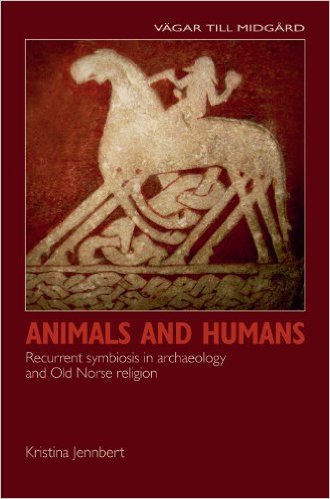Animals and Humans: Recurrent Symbiosis in Archaeology and Old Norse Religion.

Animals and Humans: Recurrent Symbiosis in Archaeology and Old Norse Religion. Kristina Jennbert. Nordic Academic Press, 2011. 272 pp. including notes, bibliography, 28 b/w illus., 13 tables, and map. $52.95 US). ISBN 978-91-85509-37-9.
Reviewed by Emily E. Auger
[This review originally appeared in Mythlore 31.1/2 (#119/120) (2012): 169–171.]
Kristina Jennbert is a Professor of Archaeology and Ancient History at Lund University, Sweden. The research for Animals and Humans was conducted between 1999 and 2005 as part of a larger multidisciplinary project at Lund University called “Roads to Midgard: Old Norse Religion in Long-term Perspectives.” Animals and Humans is a summary of archaeological work done at prehistoric Scandinavian sites and an interpretation of the materials recovered insofar as they pertain to the relationship between humans and animals. The treatment of material culture recovered from prehistoric archaeological contexts as evidence of intellectual culture involves the numerous challenges of ethnographic comparison. Though called by different names and qualified by changing perspectives on the nature of culture in general, this method is one of the few available to interpreters of prehistoric material. It involves the analysis of archaeological material, both objects and contexts, with reference to the known practices and texts of literate peoples in the surrounding regions or of a later period in the same region.
In the introductory chapter 1, Jennbert prepares her readers for the detailed study that follows with a discussion of methodology, a map, and a general chronology specific to the region. She draws attention to some of the practices that disappeared with the Christianization of the region c. 900–1000 and to some of the texts, such as the Elder Edda and Snori Sturluson’s Younger Edda (c. 1220), used later for purposes of discussion and comparison. Chapter two “Animals in Norse mythology” summarizes some of the relevant contents of these documents. Tables lay out the names assigned in the Younger Edda to different animals and birds, such as horses, cattle, goats, pigs, dogs, and others. Chapter three does the same for the appearance of animals in archaeological contexts. Tables are again used to summarize such points of interest as the sheer quantity of such remains on Iron Age (500 BC–1050 AD) farms in different regions. Descriptive sections are divided between domesticated animals (cattle, sheep/goat, pig, dog, horse, cat, poultry, and pets) and discussion sections are dedicated to farming, game, hunting (including a chart showing the bird species in Swedish “falconry graves”), and animals in rituals. The latter section is subdivided by the varying contexts of houses, cult houses, graves, animal graves (with subsections for cattle, dog, horse, bear and reindeer), and so forth.
Chapters 4, 5, and 6 are interpretive. Chapter 4 “Animals between context and text” proposes the understanding of specific aspects of the archaeological material, particularly animals in burial contexts, relative to a pre-Christian world view as expressed in and contrasted with that represented in Snorri’s Edda, as well as Proto-Norse and Norse runic inscriptions. Jennbert favors the reading of these materials in terms of “bodily metaphors,” because, as she explains:
Bodies of both humans and animals are profusely represented in the archaeological record, reflecting many different patterns of action. They were transformed through fire and other processes, which shows that humans and animals were viewed in the same way, with significant associations between them. The handling of bodies throughout the pre-Christian period indicates that the ritualization of entire bodies and body parts—both human and animal—was significant. […] The clearest traces of concrete attitudes and strategies to humans and animals concern death and burial. (125)
She continues with a discussion of the treatment of both complete bodies and body parts and proposes that the parts had meanings similar to those of the kennings found in the Eddas, in which blood may be referred to as “warm ale” and the heart as the “power-stone” (129).
Chapter 5 “A Midgard mentality—why animals?” lends more attention to the working relationships between humans and animals, again with separate discussion sections for particular species. These relationships are categorized in various ways. For example, the practical uses of animals as food and raw material are identified, as are the ways animals are related to human social identity and status through such strategies as the assignment of human names to animals and the creation and use of visual images showing transformations between animals and humans.
Chapter 6 “Old Norse religion” considers the relevance of a shamanistic cultural analysis of the archaeological material and highlights some of the changes in the visual arts that coincide with the Christianization of the region. Chapters 7 “The archaeology of religion” and 8 “To interpret interdependence over time” provide short summaries of the conclusions of the study, restatements of some of the methodological difficulties involved in the interpretation of prehistoric materials, and some brief comments about the ongoing relevance of the subject of human–animal interactions today.
Animals and Humans was written for archaeologists and advanced scholars of any discipline interested in prehistoric northern cultures, shamanism, or pre-Christian religion. In addition, it may be of interest to scholars in pursuit of an understanding of the cultural world that preceded and formed the context for some of the literary works frequently cited as Tolkien’s sources of inspiration. Its chapters and sections are logically ordered, but at times the style of presentation seems intended to facilitate consultation of the different sections independently. This design serves the consultative and encyclopedic use of the book, a feature that will not deter and may even delight some, but may also detract from its appeal to more general readers looking for a cover-to-cover reading experience.

